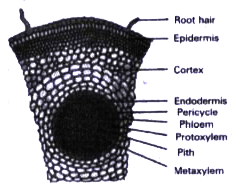Describe the internal structures of a Monocot Root .Solution in Telugu
The internal structure of a Monocot root shows 3 zones .
They are : (1) Epidermis (2) Cortex and (3) Stele .
(1) Epidermis : It is the outermost layer formed by thin walled , rectangular cells , which are compactly arranged without intercellular spaces . Cuticle and stomata are present are absent .Some epidermal cells (trichoblasts ) produce tubular extensions called root hairs . They are : (a) Exodermis (b) General cortex and (c ) Endormis .
(2) Cortex : It is wide and extensive tissue present between the epidermis and stele . It is bigger than the stele . It can be divided into three sub - zones .They are :(a) Exodermis (b) general cortex and (c ) Endodermis .
(a) Exodermis : it is the outer part of the cortex and composed of one of two rows of thick walled , dead , suberised calls . In mature roots , when the outer epidermic is removed , the exodermis acts as a protective layer . It helps in preventing the exit of water from the root tissues.
(b) General Cortex : It is formed below the exodermis layer . It is composed of several rows of thin walled living cells that are arranged lossely showing intercellular spaces . The cells of cortex help in the storage of food materials and latera conduction of water from the epidermis to the stele .
(c) Endodermis : The innermost layer of cortex and is composed of single layer of barrel shaped cells that are arranged compactly without intercellular spaces . The radical and transverse walls are wrapped by ligno - suberised bands called casparian bands . These are known as passage cells which help in the entry of water from the cortex into the stele .
(3) Stele : The central conducting cylinder . It is very prominent and bigger in size . The stele shows Pericycle , Vascular bundles and Medulla .
(i) Pericycle : The layer of cells found beneath the endodermis in known as pericycle . The cells are thin walled , parenchymatous , rectangular and compact without intercellular spaces . The cells are meristematic and divide actively producing lateral roots . In old and mature roots , the pericycle is sclerenchymatous and gives mechanical strength .
(ii) Vascular bundles : Bundles of xylem and phloem are found separately on different radii , one alternating with the other , at the peripheral boundary of the slele . These are known as radial or separate vascular bundles . The xylem is exarch and polyarch . More than six xylem bundles .
The ground tissue formed between the xylem and phloem stands is known as .conjunctive tissue . . It is usually parenchymatous .It helps in storage of food materials and provides mechanical strength .
(iii) Medulla or Pith : The wide central part of the stele is called .medulla or pith . . It is made up of thin walled parenchyma which primary helps in the storage of food . In some monocot roots , the medulla is composed of thick walled lignified dead sells and helps in giving mechanical strength .

Topper's Solved these Questions
- BOOK - VIKRAM PUBLICATION ( ANDHRA PUBLICATION)CHAPTER - HISTOLOGY AND ANATOMY OF FLOWERING PLANTS EXERCISE - TEXTUAL EXERCISES3videos
HISTOLOGY AND ANATOMY OF FLOWERING PLANTS
- BOOK - VIKRAM PUBLICATION ( ANDHRA PUBLICATION)CHAPTER - HISTOLOGY AND ANATOMY OF FLOWERING PLANTS EXERCISE - IMPORTANT QUESTIONS7videos
HISTOLOGY AND ANATOMY OF FLOWERING PLANTS
- BOOK - VIKRAM PUBLICATION ( ANDHRA PUBLICATION)CHAPTER - HISTOLOGY AND ANATOMY OF FLOWERING PLANTS EXERCISE - SHORT ANSWER TYPE QUESTIONS10videos
HISTOLOGY AND ANATOMY OF FLOWERING PLANTS
- BOOK - VIKRAM PUBLICATION ( ANDHRA PUBLICATION)CHAPTER - ECOLOGY AND ENVIRONMENT EXERCISE - IMPORTANT QUESTIONS45videos
ECOLOGY AND ENVIRONMENT
- BOOK - VIKRAM PUBLICATION ( ANDHRA PUBLICATION)CHAPTER - LOCOMOTION AND REPRODUCTION IN PROTOZOAEXERCISE - Important Questions13videos
LOCOMOTION AND REPRODUCTION IN PROTOZOA
Similar Questions
Name the various kinds of cell layers which constitute the bark .
02:25View SolutionWhy are xylem and phloem called complex tissues?
02:37View SolutionState the location and function of different types of meristem.
02:25View SolutionDefine the term "ecology" and its branches.
02:37View SolutionList any two differences between a flagellum and a cilium.
06:02View Solutionएकबीजपत्री तने की आन्तरिक संरचना को चित्र की सहायता से समझाइए।
05:03View Solutionएकबीजपत्री जड़ की संरचना का सचित्र वर्णन कीजिए।
06:51View SolutionDescribe the internal structure of a monocot stem.
05:58View SolutionDescribe the vascular bundle of a monocot root.
06:09View SolutionDescribe internal structure of microsporangium
05:54View SolutionDescribe internal structure of dicot root.
OR
Describe internal structure of sunflower root.01:24:02View SolutionDescribe internal structure of monocot (Maize) root.
04:34View SolutionDescribe internal structure of monocot stem.
04:06View SolutionDescribe internal structure of Polyarch Root with figure.
01:32View SolutionExplain the primary structure of monocot root.
View Solution

